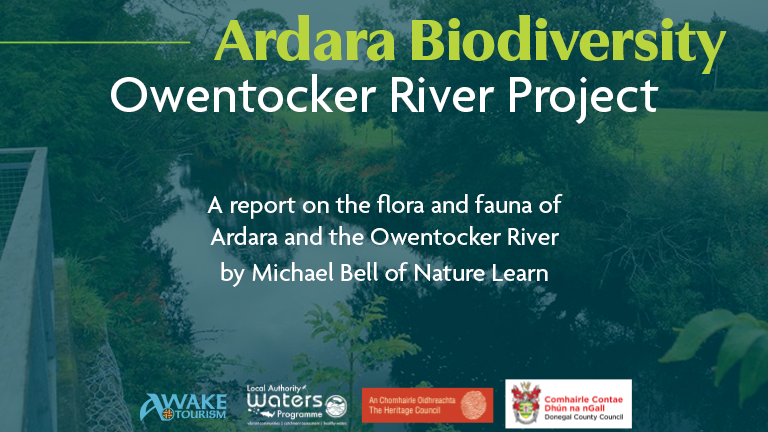Discovering Ardara’s Rich Natural Tapestry: Insights from the Latest Biodiversity Report
Conducted by NatureLearn with funding granted by the Local Authority Waters Programme the Ardara Biodiversity report was launched in 2022. The recent biodiversity report compiled by Michael Bell of Nature Learn offers fascinating insights into Ardara’s natural offerings, stressing the importance of ecological preservation for future generations. Nestled in the heart of County Donegal, the picturesque town of Ardara, known for its rich heritage, is not just a cultural hub but also a haven for biodiversity.
Ardara: A Melting Pot of Habitats and Species
The comprehensive survey, covering various forms of life from plants to mammals and insects, paints Ardara as a mosaic of habitats. Key to Ardara’s biodiversity is its built environment, characterized by the harmonious coexistence of urban life with nature. The town, awarded the title of the best village to live in Ireland in 2012, boasts well-maintained planters that, beyond adding aesthetic value, support pollinating insects.
Private gardens, though outside the survey’s scope, hold potential as wildlife hotspots. Encouraging residents to report their wildlife encounters could unveil the presence of species like foxes or hedgehogs, enhancing the town’s biodiversity records.
Moreover, Ardara’s bird population is as diverse as it is vibrant. Species range from the common house sparrows and starlings to swallows and house martins, the latter likely nesting within the town and environs. Awareness initiatives about garden wildlife could bolster conservation efforts, as private green spaces become crucial wildlife sanctuaries.
The Owentocker River: A Lifeline for Local Biodiversity
Central to Ardara’s natural heritage is the Owentocker River. This waterway supports an ecosystem brimming with life, underscored by its history as a coveted spot for anglers chasing Atlantic salmon and sea trout. The river’s health, reflected in its high water quality (as per the 2021 data from Catchments.ie), is paramount for local drinking water and biodiversity.
The river wasn’t always this pristine. Historical data reveals past struggles, with water quality only reaching good status in 2009. The presence of Atlantic salmon, brown trout, and European eel underscores the river’s ecological importance. The Owentocker’s banks also support various bird species, from dippers and grey wagtails to the elusive kingfishers and grey herons.
Enhancing the river’s mystique are the nocturnal murmurs of the otters and the flutters of Daubenton’s bats, reminding us that many of Ardara’s wildlife wonders are shrouded in the veil of night.

The otter is undoubtedly a common traveller along the Owentocker River but rarely seen due to its mainly nocturnal habits and secretive nature (© Molly Bell)
Exploring Ardara’s Walking Routes: A Symphony of Flora and Fauna
The biodiversity report highlights several walking routes, such as the Drumbarron Walk and Biodiversity Lane, each offering a unique glimpse into Ardara’s wildlife. Drumbarron Walk, for instance, is a botanist’s dream, featuring plants that some might dismiss as weeds but are vital for local ecosystems. Here, gorse, thistles, nettles, and ragwort are not just plants but lifelines for numerous insects and birds.
Biodiversity Lane, accessible from Drumbarron Walk, is a testament to Ardara’s wooded beauty. The area is a symphony of birdsong, where the melodies of willow warblers, chiffchaffs, and blackcaps create a natural orchestra. The woodland also serves as a refuge for various mammals, though they’re often the unseen residents of this natural abode.

Freshwater shrimp (Gammarus sp.) recorded from the Owentocker River on 31st May 2022. Macro-invertebrate sampling helps to determine water quality in rivers.
The Need for Community Engagement in Conservation
The report is more than a catalogue of species; it’s a call to action for Ardara’s residents. By logging wildlife sightings with the National Biodiversity Data Centre, locals can become citizen scientists, contributing to the town’s conservation efforts.
Conclusion
Ardara’s heritage isn’t just woven through its music, festivals, or architecture—it thrives in its woodlands, riverbanks, and skies. The biodiversity report serves as a blueprint for future conservation efforts, ensuring that Ardara remains a sanctuary for both its people and the myriad species calling it home.
To download and read the full report see here.
